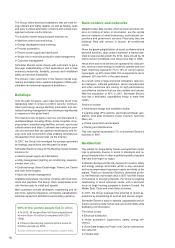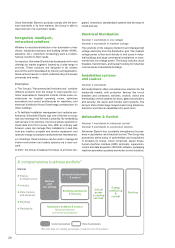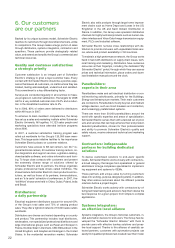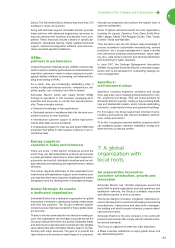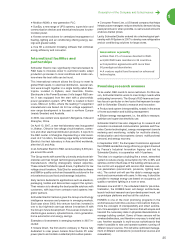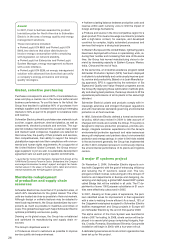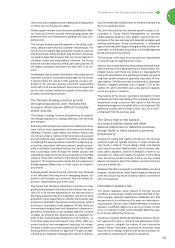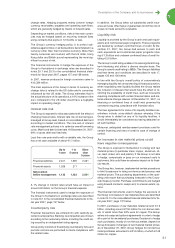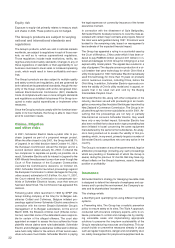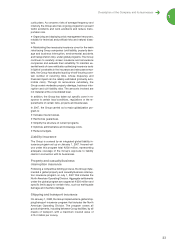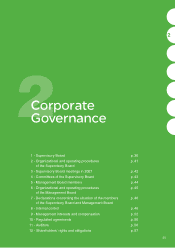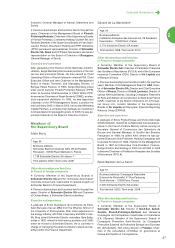APC 2007 Annual Report Download - page 30
Download and view the complete annual report
Please find page 30 of the 2007 APC annual report below. You can navigate through the pages in the report by either clicking on the pages listed below, or by using the keyword search tool below to find specific information within the annual report.28
Attracting and developing talent
The diversity of the countries, markets and customers
served by Schneider Electric is reflected in its workforce.
The Group is committed to developing and promoting
multi-cultural teams with managers from different countries
who are able to take on major responsibilities in a decen-
tralized organization. This policy helps Schneider Electric
attract, lock-in and develop the best people in its 106 host
countries.
The Group encourages geographic mobility and nurtures
international leadership. This is one of the goals of the
Marco Polo international hiring program, which recruits
some 100 people a year. Marco Polo gives high potential
graduates interested in international mobility the opportu-
nity to kick off their Schneider Electric careers with a job in
a foreign country.
Training is a key success factor at all levels of the organi-
zation. Schneider Electric has developed partnerships with
prestigious business and engineering schools and targeted
universities around the world. In 2007, it stepped up its pro-
grams with INSEAD in France, ESE in Barcelona and the
London Business School to bolster MBA recruitment.
Also during the year, Schneider Electric University consid-
erably expanded its programs on customer focus, contin-
uous change, leadership skills and attitudes and
professional expertise through several specialized insti-
tutes.
During the year, 1,837 participants representing 71 na-
tionalities attended seminars on developing leadership and
global expertise. The number of women in attendance was
up 155%. More than 800 customers around the world were
interviewed as part of these programs.
The university opened two new institutes in 2007: Finance
and Control and Human Resources.
More than 7,000 employees benefited from e-learning, no-
tably for English language training. More than 6,000 re-
ceived training locally thanks to the deployment of the
Schneider Electric institutes’ programs in the Country Or-
ganizations.
The Group is also deeply committed to keeping its em-
ployees’ competencies fresh through regular evaluations,
appropriate information and training and skills certification
programs. When headcount needs to be scaled back, the
units take vigorous steps to find inplacement solutions or
to help those made redundant to start their own busi-
nesses. (See Schneider Electric’s social performance in-
dicators, pages 77 to 98).
In 2007, Schneider Electric and the European Metalwork-
ers' Federation (EMF) signed an innovative European
agreement on anticipating employment needs and skills,
promoting social dialogue and professional training during
cross-border organizational changes. This agreement will
allow Schneider Electric to maintain its competitiveness
while ensuring its team members’ development and em-
ployability.
Lastly, the Group gives employees a stake in achieving tar-
gets and in Schneider Electric’s performance through
profit-linked incentive plans, employee share ownership,
stock option programs and bonuses. In the spring of 2007,
the Group carried out a share issue open to members of
the employee stock purchase plan or entities set up to hold
shares on the behalf of employees.
9. Risk factors
Risk factors related
to the Company’s business
The Group operates worldwide, in
competitive and cyclical markets
The worldwide markets for the Group’s products are com-
petitive in terms of pricing, product and service quality, de-
velopment and introduction time and customer service. The
Group faces strong competitors, some of whom are larger
or developing in certain lower cost countries. The Group is
exposed to cyclical fluctuations in the rate of economic
growth of, and level of capital expenditures in, the various
countries in which it operates, though the impact of down-
turns in a particular market may be limited by the diversi-
fied nature of its end user markets.
As the Group also operates in emerging or developing
countries for 32% of its business, it is exposed to the risks
associated with those markets.
The Group’s wide international presence exposes it to
many economic, legal and political risks in its host coun-
tries. These include risks arising from social unrest (partic-
ularly, strikes and walk-outs), political instability, unforeseen
regulatory changes, restrictions on capital transfers and
other obstacles to free trade, and local tax laws, all of which
may have an adverse effect on the Group’s business, re-
sults of operations or financial position.
The Group has implemented procedures designed to pro-
tect it from the effects of these risks, which are generally
beyond its control, and to manage them as effectively as
possible. The protection provided by these measures may
nevertheless prove to be inadequate.
The development and success
of our products depends on our ability
to develop new products and services
and adapt to the market and to customer
needs
The markets in which we operate experience rapid and sig-
nificant changes due to the introduction of innovative tech-
nologies. Introducing new technology products and
innovative services, which we must do on an ongoing basis
to meet our customers’ needs, requires a significant com-
mitment to research and development, which may not re-
sult in success. Our revenue and margins may suffer if we
invest in technologies that do not function as expected or
are not accepted in the marketplace or if our products, sys-
tems or service offers are not brought to market in a timely
manner, become obsolete or are not responsive to our cus-
tomers’ requirements.
In order to meet these challenges, the Group has an R&D
budget, which, at more than 4% of revenue, is among the
highest in the industry. R&D involves some 6,500 employ-
ees around the world, a number of them in development
centers located in 25 countries. This ongoing commitment
has allowed the Group to accelerate time to market and
leverage the technology of strategic partners with whom it
has also forged alliances to expand its lineup or geographic
coverage. The Group has brought together all of its elec-
trotechnical, electronic, electromechanical, software and


